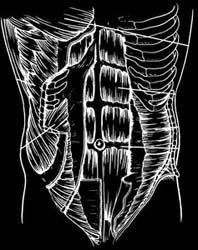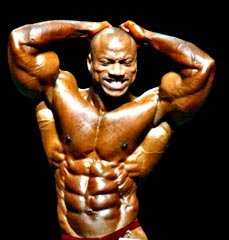You rarely find anyone gracing the pages of any magazine without a solid six pack. Your arms can be popping with muscles, your quadriceps ripped and striated with veins, but if you do not have an impressive six-pack, the impression those have of you will be less than perfect so to achieve a complete body one must train their abs smart and effectively.

Abdominal Physiology

 To fully understand how to best develop your abs, you first must know what they are, what they do, and how they affect the rest of your body. The rectus abdominis is essentially a long, flat muscle that originates from the pelvic area and inserts into the lower ribcage. This muscle's basic job is to contract through a very short range of motion and draw the pelvis and ribcage together, bending the spine forward. It also helps stabilize the torso. This is all the abdominals do; they do not lift the torso or elevate the legs. Any exercise that does not involves this basic crunching movement or folding of the torso is not a primary abdominal movement.
To fully understand how to best develop your abs, you first must know what they are, what they do, and how they affect the rest of your body. The rectus abdominis is essentially a long, flat muscle that originates from the pelvic area and inserts into the lower ribcage. This muscle's basic job is to contract through a very short range of motion and draw the pelvis and ribcage together, bending the spine forward. It also helps stabilize the torso. This is all the abdominals do; they do not lift the torso or elevate the legs. Any exercise that does not involves this basic crunching movement or folding of the torso is not a primary abdominal movement.
A long slender muscle running vertically down the abdomen, the rectus abdominis is halved by tendinous strips that provide the divisions usually seen in people who are pretty ripped. The external oblique muscles cover the front and sides of the abdomen from the rectus abdominis to the latissimus dorsi, and their fibers run diagonally to from a V shape. Located directly underneath the external obliques, the fibers of the internal obliques form an inverted V shape.
Since the physiology of abdominal training has not been well recognized since the 1980s and 90s, it was once though that full sit-ups and leg raises were fundamental exercises for training abs. With the induction of the 21st century, sit-ups and leg raises have been laid to rest because they are not essential abdominal exercises. These types of exercises actually work the hip flexors and the abdominals act primarily as stabilizers of the torso.
To make this easier to understand, stand on one leg and grasp something for support. Place your free hand onto your stomach and lift one leg or knee upward. Notice that your abdominals do not contract. It takes your hip flexors to lift the legs, not your abs. The lower abdominals are partially involved but not to the point where the exercise is devoted to training the lower abdominals.

Abdominal Exercise

For any type of abdominal movement to effectively train the abs, it must require that crunching movement or folding of the torso as I mentioned earlier. With a traditional crunch, you lie on your back with your feet up on a bench or in the air where you are balancing them and roll your upper body toward your pelvis by contracting your abs. During this movement, you are also pressing your lower back into the floor. The basic abdominal crunch effectively defines and increases abdominal mass.
To make the exercise more difficult, place your feet on a bench or against the wall. While the crunch tends to emphasize the upper portion of the abdominal muscles, the lower portion, along with the hip flexors, contracts to maintain stability in the lower ab-hip region to allow for proper upper body movement. The muscles involved include the rectus abdominis, external and internal oblique.
 The reverse crunch stabilizes your upper torso to put the focus on the lower abs. The reverse crunch uses the weight of your legs to add resistance. To perform the reverse crunch, lie faceup with your arms along side your body. Bend your knees and raise your thighs until they are perpendicular to the floor, which is the starting position. Inhale and hold your breath as your contract your abdominal muscle to pull or roll your pelvis up toward your chest. Your knees should move relatively close to your chest and your pelvis should come completely off the floor.
The reverse crunch stabilizes your upper torso to put the focus on the lower abs. The reverse crunch uses the weight of your legs to add resistance. To perform the reverse crunch, lie faceup with your arms along side your body. Bend your knees and raise your thighs until they are perpendicular to the floor, which is the starting position. Inhale and hold your breath as your contract your abdominal muscle to pull or roll your pelvis up toward your chest. Your knees should move relatively close to your chest and your pelvis should come completely off the floor.
As you crunch, keep your knees bent so that muscular contractions do the work instead of momentum. Squeeze your abs at the top and slowly lower yourself back to the starting position. For an even stronger contraction of the lower abs, hold your head and shoulders up. This tightens the upper abdominal region so that when the lower aspect shorts, it works harder to raise your hips.
Hanging leg or knee raises involve the same crunching movement, only with your body in a vertical position. Keeping your legs straight during the movement makes this lower-ab exercise even tougher. To perform this exercise jump or step up to a high bar so that when you grasp the bar your body hangs without your feet touching the floor or you can perform this exercise on a vertical bench.
Fully extend your arms and lower body when hanging from the bar. Your lumbar spine should be slightly arched. Inhale and hold your breath as you first bring your legs slightly behind your body, then quickly raise them forwards and upward as high as possible. Keep your legs straight but not locked out.
If you have tight hamstrings, keep a slight bend in the knee. For the exercise to be most effective, your legs should come above the level position, at which point you should hold the peak contraction for 1-2 seconds as you exhale. Relax slightly as you return to the starting position. If this exercise is too difficult to perform with straight legs bend your knees further to decrease the resistance. The key is to allow your pelvis to rotate maximally as your legs rise. Concentrate on curling your pelvis after you get your legs moving upward.

Take It Easy On the Obliques

The obliques are generally the muscles that make your waist too big. Powerful obliques are important stabilizers for powerlifters, football lineman, and other strength athletes, but if you want to create a lean, defined torso, then it is better to rarely train your obliques with weights. They already get a workout when you do a heavy upper-body exercise and squatting exercises. Doing weight oblique work tends to thicken your waistline instead of tapering it.
Side bends without weight or twisting crunches should be enough. Another strategy for keeping your waistline small is to perform stomach vacuums. They are great for exercising control of your abdominals and taper your waist.
Training the abdominals are the same for men and women but results are determined largely by your gender. Men naturally carry the majority of their fat around their waist, whereas women tend to carry theirs on their hips and thighs. Thus, it is harder for a man to get his abs to appear. He must be extremely lean. Regardless of your gender, developing your abs occurs between the pelvis and the ribs. Remember to train your abdominals and not your hip flexors to achieve a streamline waist.
Get Perfect Abs!
Thanks,
